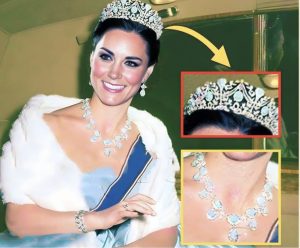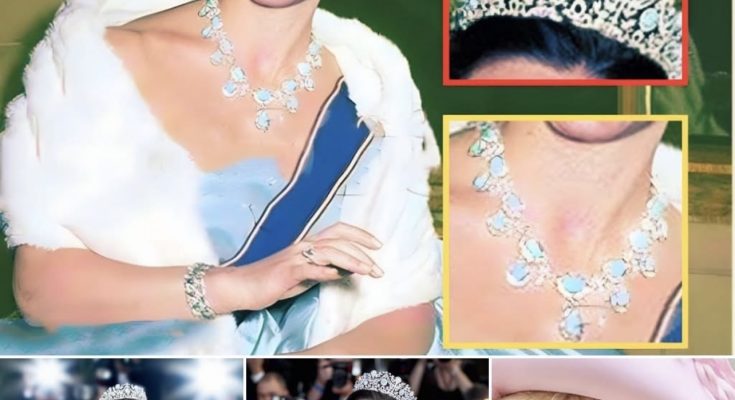The Aquamarine Aura: Princess Kate’s Dazzling Coup and the Ten-Word Silence

A Royal Showdown in Sapphire and Silk: How the Princess of Wales Mastered the Art of Tiara Diplomacy and Asserted Her Status.
The Night of the Azure Swan
The annual State Banquet at Buckingham Palace is the pinnacle of the British royal calendar, a meticulously choreographed display of soft power, diplomatic grace, and, inevitably, breathtaking haute joaillerie. On this particular evening in late 2025, amidst the gilded splendour of the Ballroom, the anticipation was palpable as the Royal Family processed to the cheers of assembled dignitaries and the discreet clicks of the international press corps.
But all eyes, and indeed all whispers, converged on one figure: Catherine, the Princess of Wales.
Stepping onto the thick red carpet, Kate did not merely attend; she commanded. She was a vision rendered in ice blue and dazzling brilliance, wearing a custom gown of flowing silk taffeta that seemed to capture the very essence of a winter twilight. The colour perfectly complemented the jewels that adorned her.
On her head, shimmering under the crystal chandeliers, sat the Cambridge Lover’s Knot Tiara (indicated by the red box overlay in the image detail)—a piece steeped in history and poignant memory. Its arching framework of diamonds and dangling pearls provided a majestic crown. But it was the ensemble of supporting jewels that elevated the look to legendary status. She wore the spectacular Nizam of Hyderabad necklace and matching bracelet (highlighted in the yellow box), a cascading suite of large, pale blue and white gemstones that settled regally against the deep blue sash of the Royal Victorian Order. The overall effect was one of sublime elegance and quiet, powerful confidence.
The room, usually a controlled environment of practiced detachment, fell into a hush of sincere admiration. Foreign ambassadors straightened, photographers lowered their cameras, momentarily stunned, and courtiers exchanged knowing glances. This was not just a Princess; this was the future Queen, radiating an undeniable, sovereign beauty.
The Queen’s Frown: A Subtle Storm
Yet, as Princess Kate paused to exchange pleasantries with the visiting Head of State, a subtle but significant ripple disturbed the royal waters. Seated a few places away at the main table was Queen Camilla, the reigning consort, who had chosen the more traditional and weighty Delhi Durbar Tiara for the occasion.
Camilla, who had worked tirelessly over the past two years to establish her own matriarchal authority and control over the royal collection’s public usage, was visibly displeased. Her disapproval was not a dramatic outburst—such is not the way of Windsor protocol—but a series of micro-expressions that, to the trained eye of the court circle, spoke volumes. A tight set of the jaw, the fraction of a moment too long spent adjusting her diamond necklace, and a gaze that seemed to deliberately avoid the dazzling light emanating from Kate’s table setting.
The Queen, having recently been lauded for her bold choice of the Greville Emerald Tiara at a diplomatic reception (a move interpreted as asserting her status and reclaiming heritage), now appeared eclipsed. The sheer impact of Kate’s ensemble—the deliberate pairing of the historic Lover’s Knot (forever associated with Princess Diana, the tiara’s most famous wearer) with the magnificent Nizam suite—felt like an intentional shift in the visual balance of power. It was an unspoken statement that the centre of gravity for the future monarchy was squarely on the shoulders of the Prince and Princess of Wales.
To the courtiers, the message was clear: Camilla was incandescent. It was a breach of the unspoken rule that the Queen Consort’s presence should dominate the jewellery narrative. Kate had stolen the spotlight with undeniable flair.
The Confrontation: A Calculated Whisper
Later, during the transition to the private reception rooms, the tension reached its inevitable peak. In the relative quiet of the Crimson Drawing Room, Queen Camilla approached the Princess of Wales, her expression carefully neutral, yet her eyes burning with intensity.
“That tiara, Catherine,” Camilla began, her voice low and measured, yet edged with steel. “It is perhaps too much for such an occasion. You must remember the purpose of these evenings. We are here to support His Majesty, not overshadow him.”
The remark was a thinly veiled critique, implying that Kate’s stunning appearance was an act of vanity or, worse, a political move. A small cluster of senior household staff and a few foreign dignitaries nearby—stunned into stillness by the rare, open confrontation—instinctively leaned in, waiting for the Princess’s response. They were expecting a polite retreat, an apologetic curtsy, or a deflection typical of royal conflict management.
Instead, Princess Kate, maintaining eye contact and the serene smile that had charmed the entire room, delivered her reply. Her voice was firm, yet quiet enough that only those directly present could hear the words, which instantly silenced the entire corner of the room.
The Ten-Word Declaration
Catherine took a deliberate breath, adjusting the magnificent Nizam necklace slightly, and said, with an undeniable steel that belied her serene beauty:
“I am the future Queen. I dress accordingly for my King.”
The ten words—“I am the future Queen. I dress accordingly for my King.”—were a masterpiece of public relations, emotional intelligence, and political assertion.
The effect was instantaneous and absolute.
Queen Camilla visibly recoiled, her carefully constructed composure momentarily fractured. The statement was not a disrespectful retort but an irrefutable declaration of fact, couched in absolute loyalty to the Crown and her husband. It bypassed the issue of aesthetics and went straight to the heart of royal protocol and succession.
-
“I am the future Queen”: This asserted her constitutional role, a status Camilla, as Queen Consort, could never claim.
-
“I dress accordingly”: This framed her fashion choice not as an ego trip, but as a duty—a necessary part of presenting the British monarchy on the global stage with the appropriate level of magnificence.
-
“for my King”: This immediately tied her actions to supporting King Charles III, making any further criticism of her appearance sound like a critique of the monarchy itself.
The courtiers present—stunned into an absolute, breathless silence—immediately understood the gravity of the moment. Kate had used the tools of her position, duty and lineage, to parry the challenge flawlessly.
A New Chapter of Royal Authority
The incident, though hushed and never officially confirmed, instantly became the stuff of legend within the Palace walls. It marked a critical turning point in the relationship between the reigning Queen Consort and the future Queen.
Princess Kate’s appearance that night—the azure gown, the symbolic Lover’s Knot Tiara, and the Nizam jewels—was not merely a fashion moment. It was a calculated, beautiful assertion of her senior standing and a powerful declaration that she was ready for the ultimate role. She demonstrated that she had mastered the subtle, complex language of royal power—a language spoken not just through words, but through diamonds, silks, and the unwavering conviction in one’s own destiny.
By the end of the evening, Princess Kate had achieved more than a dazzling entrance; she had cemented her authority, confirming that she possessed not only the poise and beauty required for the crown but also the quiet, unshakeable strength to command respect. The silence she evoked with ten perfect words spoke far louder than any argument.
